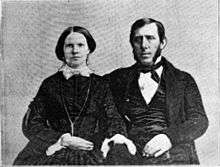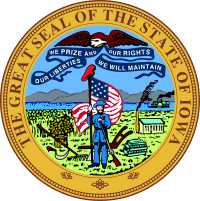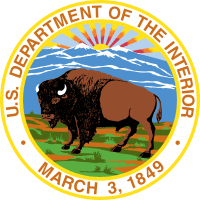Samuel J. Kirkwood
| Samuel Jordan Kirkwood | |
|---|---|
 | |
| 14th United States Secretary of the Interior | |
|
In office March 8, 1881 – April 17, 1882 | |
| President |
James A. Garfield Chester A. Arthur |
| Preceded by | Carl Schurz |
| Succeeded by | Henry M. Teller |
| United State Senator from Iowa | |
|
In office March 4, 1877 – March 7, 1881 | |
| Preceded by | George G. Wright |
| Succeeded by | James W. McDill |
|
In office January 13, 1866 – March 3, 1867 | |
| Preceded by | James Harlan |
| Succeeded by | James Harlan |
| 5th & 9th Governor of Iowa | |
|
In office January 13, 1876 – February 1, 1877 | |
| Lieutenant | Joshua G. Newbold |
| Preceded by | Cyrus C. Carpenter |
| Succeeded by | Joshua G. Newbold |
|
In office January 11, 1860 – January 14, 1864 | |
| Lieutenant |
Nicholas J. Rusch (1860-1862) John R. Needham (1862-1864) |
| Preceded by | Ralph P. Lowe |
| Succeeded by | William M. Stone |
| Member of the Iowa Senate | |
|
In office 1856–1859 | |
| Personal details | |
| Born |
December 20, 1813 Harford County, Maryland, US |
| Died |
September 1, 1894 (aged 80) Iowa City, Iowa, US |
| Political party | Republican |
| Spouse(s) | Jane Clark |
| Profession | Politician, Miller, Lawyer, Clerk, Teacher |
Samuel Jordan Kirkwood (December 20, 1813 – September 1, 1894), was an American politician best known as Iowa's American Civil War Governor. He also served in the U.S. Senate and as U.S. Secretary of the Interior.
Early life and career

Samuel J. Kirkwood was born in 1813 in Harford County, Maryland. At age 17, he began teaching school and had as one of his pupils his cousin Daniel Kirkwood, who later achieved prominence as a mathematician and astronomer.[1] Samuel spent part of his youth in Washington, D.C.,[2] then joined his father in moving to Ohio in 1835.[3] There he became a well-known anti-slavery Republican. He was elected to several state offices and worked closely with Thomas Bartley, the future governor of Ohio, in the 1840s.

In 1855 Kirkwood moved to Iowa, living northwest of Iowa City, and became involved with the Clark family, also from Ohio, in a milling venture, and then with the Clark and Lucas families in land speculation. Kirkwood married Jane Clark, the sister of Ezekiel Clark, and thus became the brother-in-law of Edward Lucas, son of Robert Lucas. Although Kirkwood intended to leave politics behind him in Ohio, he took an interest in the newly founded Republican Party. Summoned from his mill at Coralville and still coated in flour dust, Kirkwood gave a rousing speech at the founding meeting of the Iowa Republican Party in February 1856. Many people credited Kirkwood’s speech and subsequent work with the success of the Republican Party in Iowa; that year he was elected to the Iowa Senate serving from 1856 to 1859.
Governorship: The Coppock Incident and the Civil War
In 1859 Kirkwood was nominated for governor and defeated Augustus C. Dodge after a bitter campaign which focused on the slave issue. In 1860, Kirkwood’s first year in office, the John Brown raid on Harpers Ferry further polarized the nation over slavery, and Kirkwood was clearly on the side of the militant abolitionists. When Barclay Coppock, a youth from Springdale, who was part of Brown’s raid, fled to Iowa, Kirkwood refused to accept extradition papers for him from Virginia, and allowed Coppock to escape.
During the Civil War, Kirkwood gained national attention for his extraordinary efforts to secure soldiers and supplies from Iowa for the Union Army. A strong supporter of President Abraham Lincoln's policies during the American Civil War, he was active in raising and equipping dozens of regiments of infantry, as well as cavalry and artillery, for the Union Army.
In 1862, he attended the Loyal War Governors' Conference in Altoona, Pennsylvania, which ultimately gave Lincoln support for his Emancipation Proclamation.[4]
Senate and Secretary of the Interior
After he left office in 1864, Kirkwood moved to a new brick house on Wyoming Road in Iowa City (now Kirkwood Avenue) and practiced law. About this time Kirkwood sold his share of the mill, part of it to his brother, William, and part to Valentine Miller. In 1865-1867, he served the remainder of James Harlan’s term in the U.S. Senate, and served in the Senate again from 1877 to 1881.[5] Between his separate terms as a Senator, he was again the Governor of Iowa from 1876 to 1877. He resigned as governor in 1877 to begin his second term as U.S. Senator. In 1881, Kirkwood resigned his Senate seat to become Secretary of the Interior under President James Garfield. He served as Interior Secretary until 1882. He unsuccessfully ran for Congress in 1886.
Kirkwood died in 1894 in Iowa City, and is buried in Oakland Cemetery.
Memorials
Kirkwood Community College in Cedar Rapids is named for the former Iowa Governor and Senator. The town of Kirkwood, Illinois is named for him as well. Along with Nobel Peace Prize winner and agronomist Norman Borlaug, Kirkwood's sculptured likeness is maintained among the two coveted statues apportioned to each state on display under the rotunda in Statuary Hall in the United States Capitol in Washington, D.C. Kirkwood Avenue in Iowa City, where he lived for much of his political career, is named for him, as is the Kirkwood Hotel in Des Moines. Kirkwood Elementary is located in Coralville, where Kirkwood ran his mill. A small, neglected monument once stood near the Morningside entrance to Iowa City High School, but this was removed in 2010. Kirkwood Boulevard in Davenport is the route of the internationally known foot race, the Bix 7.
References
Bibliography
- Aurner, Charles R. (1912)Leading Events in Johnson County, Iowa, History. Western Historical, Cedar Rapids, Iowa.
- Parish, John C. (1921) The Miller of Coralville. In Yearbook of the Old Settlers Association: 1920–1921, pp. 6–18. Johnson County Old Settlers Association, Iowa City, Iowa.
- Dan E. Clark (1917) Samuel Jordan Kirkwood, Iowa City
- Henry W. Lathrop (1893), The Life and Times of Samuel J. Kirkwood, Iowa's War Governor, Chicago
External links
| Wikimedia Commons has media related to Samuel Jordan Kirkwood. |
- Essay on attitude of Iowans and Governor Kirkwood to the US Civil War draft, by N.H. Brainerd, military secretary to Governor Kirkwood.
- United States Congress. "Samuel J. Kirkwood (id: K000242)". Biographical Directory of the United States Congress.
| Political offices | ||
|---|---|---|
| Preceded by Ralph P. Lowe |
Governor of Iowa January 11, 1860 – January 14, 1864 |
Succeeded by William M. Stone |
| Preceded by Cyrus C. Carpenter |
Governor of Iowa January 13, 1876 – February 1, 1877 |
Succeeded by Joshua G. Newbold |
| Preceded by Carl Schurz |
U.S. Secretary of the Interior Served under: James A. Garfield, Chester A. Arthur March 8, 1881 – April 17, 1882 |
Succeeded by Henry M. Teller |
| United States Senate | ||
| Preceded by James Harlan |
U.S. Senator (Class 3) from Iowa January 13, 1866 – March 4, 1867 Served alongside: James W. Grimes |
Succeeded by James Harlan |
| Preceded by George G. Wright |
U.S. Senator (Class 2) from Iowa March 4, 1877 – March 7, 1881 Served alongside: William B. Allison |
Succeeded by James W. McDill |


